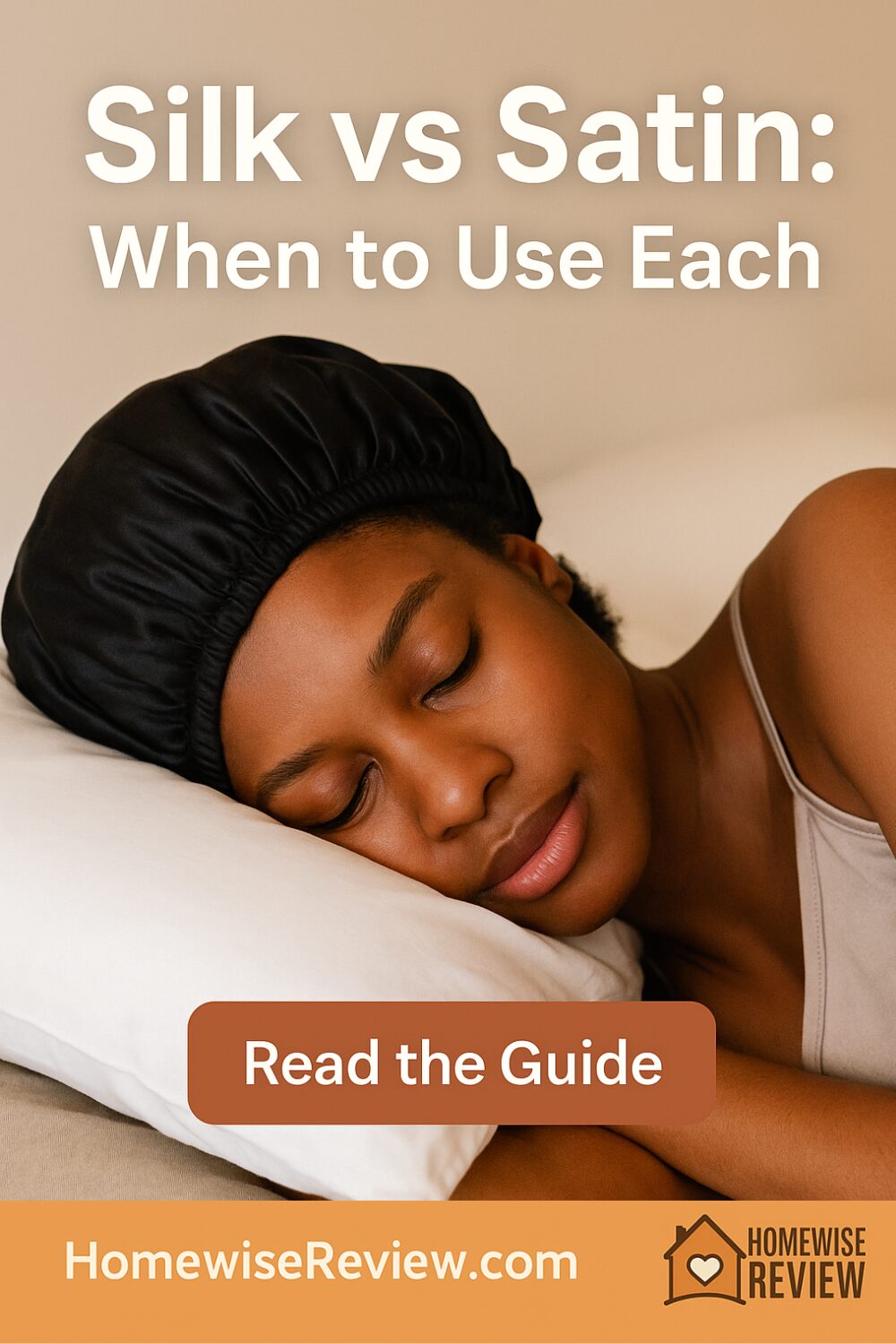
Keep moisture in, reduce friction, wake up with fewer tangles.
Night protection matters as much as wash day. The right fabric lowers friction so coils glide instead of snag, and it helps your products stay on your hair instead of your pillow. This guide breaks down silk and satin, when to choose a bonnet or a pillowcase, and how to set your hair up for fewer knots and better definition by morning.
Silk vs satin in plain English
- Silk is a natural fiber. It breathes well, glides smoothly, and helps reduce moisture loss from hair and skin.
- Satin is a weave with a shiny face. It can be made from polyester, rayon, or silk. Polyester satin is common and budget friendly, with good slip but less breathability than silk.
Bottom line: Both can reduce friction. Silk is the premium, breathable option. Polyester satin is the affordable workhorse that still protects styles if you keep heat and sweat in mind.
Bonnet vs pillowcase: quick picks
Choose a bonnet when:
- You wear twists, braids, flexi rods, rollers, or loc styles that need containment.
- Your hair is shoulder length or longer and tangles while you sleep.
- You toss and turn and need full coverage to keep edges from rubbing.
Choose a pillowcase when:
- Bonnets slip off or feel too warm.
- You sleep with short hair, a teeny weeny afro, or a silk press that you want to wrap.
- You want face-skin benefits too, like less pillow friction on cheeks.
Best of both: use a bonnet plus satin or silk pillowcase so you still get protection if the bonnet comes off.
Match by hair type and situation
- Type 3 curls: Satin bonnet or pillowcase works most nights. Switch to silk in hot rooms or if you wake up frizzy and dry.
- Type 4 coils and 4C: Bonnet first choice for full coverage. Add silk if you live in a dry climate or run a heater overnight.
- Locs: Oversized bonnet or durag with a satin pillowcase. The extra length needs containment so lint does not wrap into locs.
- Protective styles under wigs: Cornrows stay smooth with a bonnet. Use a pillowcase as backup.
- Silk press: Silk or satin pillowcase plus a wrap. Avoid tight bonnets that can crease hair.
- Hot sleepers: Silk breathes better. If you prefer satin, choose a looser bonnet with vents and keep the room cooler.
Moisture, porosity, and product load
- Low porosity hair: Avoid heavy, occlusive layers at night. Use a light leave-in, then bonnet. If hair feels coated in the morning, switch to a silk pillowcase and reduce product.
- High porosity hair: Benefit from a bit more sealing on ends. Silk bonnet or pillowcase helps slow overnight moisture loss.
- If scalp gets sweaty or itchy: Rotate clean bonnets and cases often. Polyester satin can feel warmer. Try silk or sleep with hair in larger, looser sections.
Fit and edge care
- Choose a bonnet with a wide, soft band that does not dig into edges.
- If bands slip, place a thin satin scarf under the band for grip without tension.
- Tuck ends fully so tips do not rub against the band.
Care and washing
- Silk: Hand wash or machine delicate in a mesh bag. Cool water, mild detergent, air dry. Skip fabric softener and bleach.
- Satin polyester: Machine wash cold, gentle cycle. Low tumble or air dry.
- Wash weekly or more often if you use heavy stylers. Clean fabric is key for scalp comfort and clearer skin.
Routine starters
Twist or braid sets
- Mist with water, add a light leave-in on ends.
- Twist in medium sections.
- Cover with a bonnet. Sleep on a satin pillowcase as backup.
Wash and go
- Scrunch out excess water with a T-shirt.
- Set with a light gel that dries clean.
- Pineapple and use a silk or satin pillowcase to avoid flattening.
Silk press
- Wrap hair smoothly with a soft brush.
- Secure with a satin scarf.
- Sleep on silk pillowcase to minimize creases.
Product picks (4)
1) Silk Bonnet
Why it works: Breathable glide that helps reduce overnight dryness and friction.
How to use: Tuck hair fully, place the band just past the hairline, and sleep on a satin or silk pillowcase as backup.
Keep in mind: Hand wash or delicate cycle only.
Who it’s for: Dry climates, hot sleepers, Type 4 coils, and locs that pick up lint.
2) Satin Bonnet
Why it works: Affordable protection with solid slip that preserves sets.
How to use: Choose a wide, soft band. If warm, switch to a looser fit.
Keep in mind: Polyester can feel hotter. Wash frequently if you sweat.
Who it’s for: Budget shoppers, teens, and protective styles that need containment.
3) Silk Pillowcase
Why it works: Smooth, breathable surface for hair and skin. Great if bonnets slip.
How to use: Pair with a loose pineapple or wrap. Rotate two cases for cleanliness.
Keep in mind: Gentle wash care to avoid snagging.
Who it’s for: Silk presses, short styles, and anyone who removes bonnets overnight.
4) Satin Pillowcase
Why it works: Easy upgrade from cotton that cuts friction and helps styles last.
How to use: Keep a spare for travel. Wash with your sheets weekly.
Keep in mind: Slightly warmer feel than silk.
Who it’s for: Everyday protection at a friendly price.
Quick fixes vs long-term habits
- Quick fix: If your bonnet keeps sliding, add a light scarf underneath or swap to a larger size with a softer band.
- Long-term: Keep two clean bonnets or cases in rotation, trim ends every 8–12 weeks, and sleep with hair contained to reduce single-strand knots.
Final Thoughts
Both silk and satin protect curls, coils, and locs by lowering friction. If you run warm or live in a dry climate, silk gives you breathable comfort with great glide. If you want simple and affordable, satin still does the job well. Pick bonnet for full coverage and set protection. Pick pillowcase for comfort and presses. Use both for a fail-safe night routine.
See also
If you are building a full nighttime setup, start with Best Natural Hair Products for bonnets, pillowcases, and gentle leave-ins that pair well with overnight protection. Then read Nighttime Routine for Natural Hair That Prevents Breakage to plug your fabric choice into a step-by-step plan.
If you wear tension styles, Edge Care Routine for Protective Styles: reduce tension and thinning shows safer habits around your hairline. Under units and sew-ins, Scalp Care Under Wigs Keep Growth Going covers cleansing access and itch control. For heat-free length, Stretching 4C Hair Without Heat Banding Guide adds next-day stretch without risking damage.
FAQs
1) Does satin still work if it is polyester?
Yes. Polyester satin has slip from the weave. It is less breathable than silk, so wash often and consider a looser fit if you run warm.
2) My bonnet leaves a dent on my edges. What should I change?
Switch to a wider, softer band or layer a thin satin scarf under the band. Avoid tight elastic and heavy edge products at night.
3) Can I just use a scarf instead of a bonnet?
Yes for wraps and presses. For coils, a bonnet gives better full coverage so ends do not rub free.
4) How many nights can I go before washing my bonnet or pillowcase?
Aim for weekly, sooner if you use heavy stylers or sweat. Clean fabric reduces itch and helps skin.
5) Will silk or satin fix dryness by itself?
No. They reduce friction and slow moisture loss. Pair with a balanced routine and light product on ends for best results.
Affiliate Disclosure
If you purchase through links on our site, we may earn a small commission at no extra cost to you.




